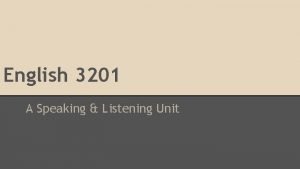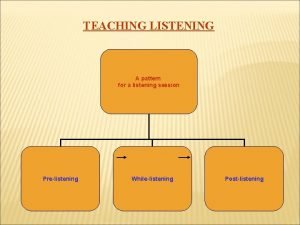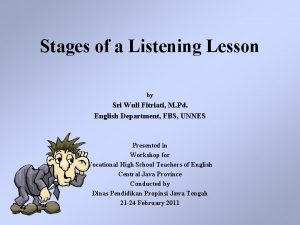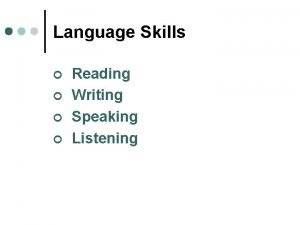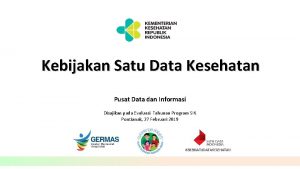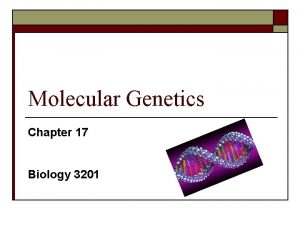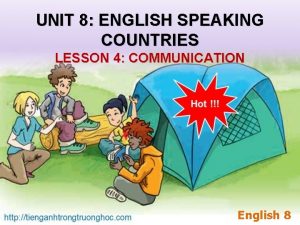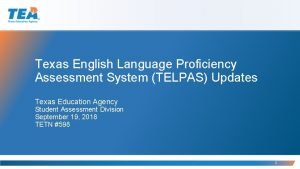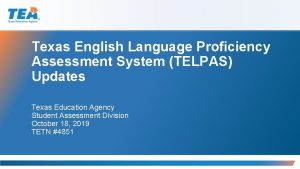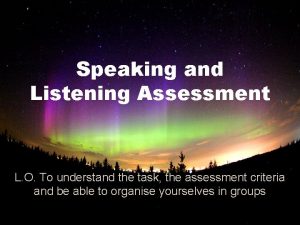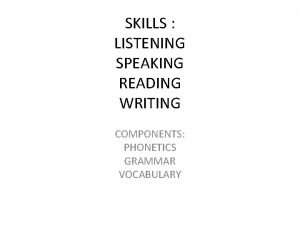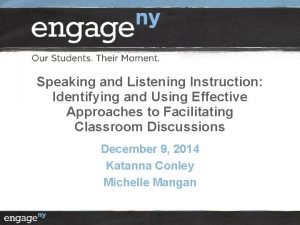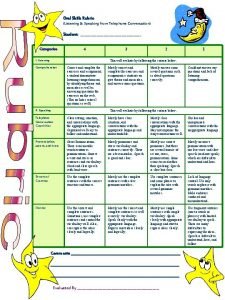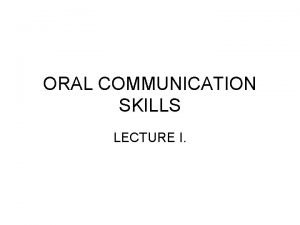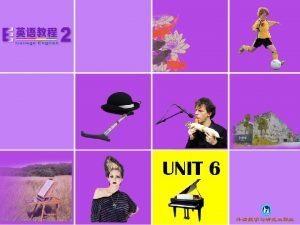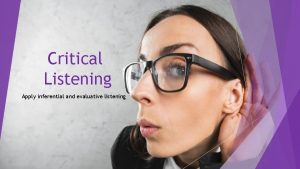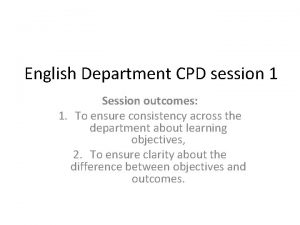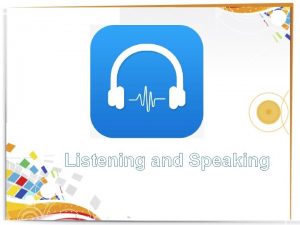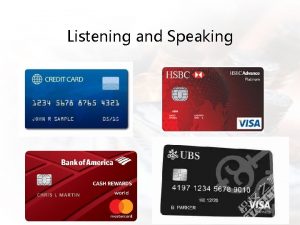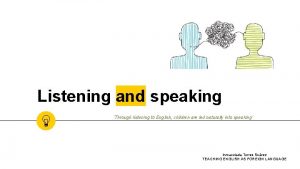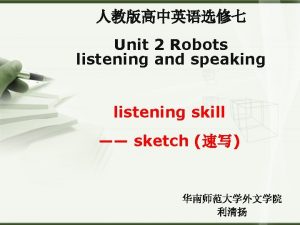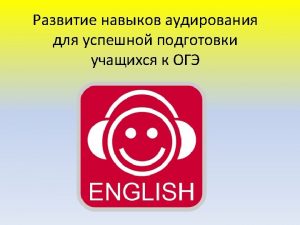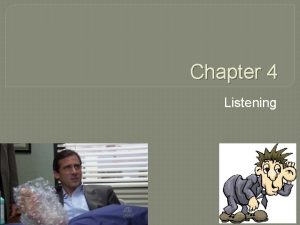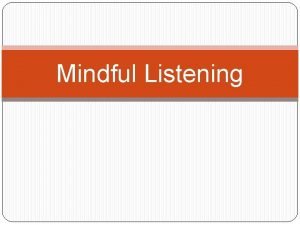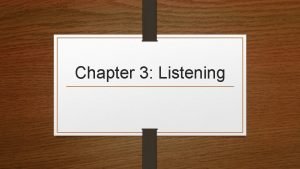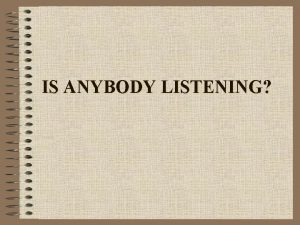English 3201 A Speaking Listening Unit Outcomes to























- Slides: 23

English 3201 A Speaking & Listening Unit

Outcomes to be Covered in English 3201 GCO 1: Students will be expected to speak and listen to explore, extend, clarify and reflect on their thoughts, ideas, feelings and experiences. 1. 0 - understand the impact of the features of oral communication in their interactions. 2. 0 - analyze concepts and information when listening 3. 0 - evaluate others’ ideas to clarify and extend their own understanding 4. 0 - examine their own thoughts and feelings through questioning and dialogue 5. 0 - advocate a position using supporting evidence

Outcomes Cont. GCO 2: Students will be expected to communicate information and ideas effectively and clearly, and to respond personally and critically. 6. 07. 08. 09. 0 - use strategies and contribute to formal and informal communication adapt language and delivery for a variety of audiences and purposes respond critically to a variety of text forms evaluate their own and others’ use of languages in a range of contexts

Outcomes Cont. . . GCO 3: Students will be expected to interact with sensitivity and respect, considering the situation, audience and purpose. 10. 0 - differentiate situations, audiences, and purposes that require varying degrees of sensitivity. 11. 0 - analyze how oral language reflects culture and identity 12. 0 - respond with the sensitivity appropriate to various situations, audiences and purposes For a detailed commentary on speaking and listening outcomes see the English 3201 curriculum guide at http: //www. ed. gov. nl. ca/edu/k 12/curriculum/guides/english/eng 3201/English_3201_Curriculum_Guide_2015_May 25. pdf

How are these outcomes assessed? In School: - various assessments throughout the year These include: listening test(s), interview assignment, panel discussion, & independent novel presentation. Public Exam: - 10 mark Listening section to be completed prior to formal exam period n(likely last week of classes). Will be in the form of fiction, nonfiction, poetry or media Will consist of FOUR selected response and ONE constructed response. Format for this component of exam will be reviewed and practiced in class.

What makes one a good speaker? ? ? TASK: In small groups (2 -4) brainstorm the many different traits needed to be considered a good speaker. Use the sheet provided to record your findings.

Traits of a good SPEAKER. . . - Speak clearly (pronunciation) Loud speaking voice Eye contact Good pace Staying on track Hand gestures when appropriate Preparedness Interacting with listeners Confident/passionate/charismat ic/likable Not monotone (voice changes) - Humour (when appropriate) Good posture Informed on topic Bling? !? !? !?

What makes one a good listener? ? ? TASK: In the same groups brainstorm as many different traits needed to be considered a good listener. Again, please use the sheet provided.

Traits of a good LISTENER. . . - Open-minded Inquisitive/asks questions Attentive/focused/responsive/N ot distracted by electronics Eye contact Appropriate posture/body language (i. e. head nodding) Provide feedback Takes notes (when necessary) Not distracting to speaker(s) Not interrupting Extending upon the ideas of the speaker(s) - Asking questions for clarification Not judging/respectful

Features of Oral Communication Language Features: - alliteration - hyperbole - imperative - lists - repetition - rhetorical questions Voice Techniques: - inflection intonation pace, pause, breathing pitch tone, emphasis volume

Language Features - alliteration- the repetition of similar sounds at the beginning of words (i. e. red rose) - hyperbole- an over-over exaggeration often used for comedic or dramatic effect. - imperative- giving an authoritative command to the audience. - lists- listing items often help the speaker to organize ideas when presenting and can allow - repetition- repeating key words and phrases/ideas important to the message/purpose of text. - rhetorical questions- posing questions to the audience that do not require formal answers.

Voice Techniques - - inflection/intonation- a rise or fall in the sound of a person’s voice which can alter the meaning of spoken words. For example, the way in which your pitch rises at the end of a question. pace/pause/breathing- pace involves how fast or slow one speaks. Sometimes speakers take pauses (breaks in speaking) to allow audience to “digest” content and allow time for breathing. pitch- refers to the highs and lows of the voice. The speaker should stay within a comfortable range in order to sound natural. tone/emphasis- tone refers to the impression the speaker wishes to create for the listener (e. g. urgent, reflective, serious. etc. ). Emphasis involves stressing particular words to convey meaning/intent and/or create interest. volume- the level at which soimething is heard.

Now it’s time to talk!! TASK: In pairs, students are to select FOUR speaking cards and discuss each in a short, productive discussion. Be sure to read/view the prompts carefully. I will make some informal notes and discuss with you next class!

Speaking Cards Activity“De-briefing” What worked well? ? - Good rapport amongst class Good “discussion posture” (students looked interested and engaged) Lively discussion at points! What needs work? ? - Staying focused on topic at hand CELL PHONES Equal contribution from all group members

INFORMAL vs. FORMAL COMMUNICATION FORMAL - formal and/or sophisticated diction - greeting before beginning - introduction of the speaker - more preparation - specific protocols INFORMAL - colloquialisms, jargon, distinct dialects, euphemisms, slang - dialect appropriate to the situation and setting - minimal preparation - use of delaying strategies (e. g. um, well, you know)

What do both types of communication have in common? - - appropriate diction and grammar appropriate gestures and body language appropriate sound devices (e. g. alliteration, assonance, cacophony, euphony, onomatopoeia) coherence throughout emphatic devices formal and informal language features and voice techniques - pause to allow other to speak strategies to engage an audience (eye contact, pace, pronunciation, etc. ) valid and convincing evidence in support of ideas

What do you think of these texts? ? Sample Text #1: Peter Mansbridge interviews Carey Price (hyperlinked)

Carey Price Interview Formal features: - Formal diction by Mandsbridge in narrating - Detailed introdcution on interviewee (Price) - Research completed by Mansbridge prior to interview (interviewed Price’s mother, quote from Dryden, etc. ) Informal features: -

Sample text #2 - Rick Mercer Rant on Veteransm (hyperlinked)

Large Group Discussion. . . - Do you think this rant was mainly formal or informal? - What do you think was the central purpose of this rant? - Who do you think was the intended audience of this rant? General or specific? - What is the dominant tone of this rant?

Sample Text #3 - General Patton’s Speech to 3 rd Army (hyperlinked)

What can we infer about General Patton based on his oral language? - Patton is very serious and passionate towards his country and winning. - He is very patriotic towards America.

Some Language Features and Voice Techiques to Consider… Language Features: Voice Techniques - Hyperbole- “we’re gonna use their guts to grease the treads of our tanks? ” - Imperative- “Now I want you to remember…no bastard…” - Repetition- the words “America” and “Americans” are repeated at several points throughout the speech - Inflection- at certain points Patton puts more emphasis on particular words. For example. “we gonna murder those bastards by the bushel!” - Tone- throughout the speech Patton exercises a very commanding, serious, passionate and even patriotic tone to his troops.
 English 3201
English 3201 What is post listening stage
What is post listening stage Stages of listening lesson
Stages of listening lesson Communication skills reading writing speaking listening
Communication skills reading writing speaking listening Satu data kesehatan
Satu data kesehatan Biology 3201 textbook
Biology 3201 textbook Unit 8 english speaking countries
Unit 8 english speaking countries Telpas listening and speaking rubric
Telpas listening and speaking rubric Telpas rubric
Telpas rubric Listening assessment criteria
Listening assessment criteria Listening speaking reading writing are the components in
Listening speaking reading writing are the components in Listening and speaking 3
Listening and speaking 3 Speaking and listening: effective group discussions
Speaking and listening: effective group discussions Listening and speaking rubric
Listening and speaking rubric Action plan for active listening
Action plan for active listening Conclusion of communication process
Conclusion of communication process Grammar listening speaking reading writing
Grammar listening speaking reading writing Grammar listening speaking reading writing
Grammar listening speaking reading writing Active listening involves
Active listening involves Evaluative listening
Evaluative listening Learning outcomes examples english
Learning outcomes examples english Learning outcomes examples english
Learning outcomes examples english English system conversion
English system conversion English speaking provinces in canada
English speaking provinces in canada
